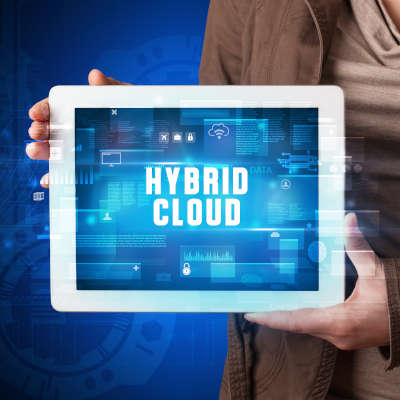Modern businesses are increasingly making use of cloud computing. They might use public cloud resources or maintain a private cloud in-house. But there’s also a third option. Some businesses take the middle ground and choose a “hybrid” cloud solution. So what makes a cloud solution “hybrid”?
What is a Hybrid Cloud Solution?
Here’s how Peter Mell and Timothy Grance defined the hybrid cloud deployment model, in Special Publication 800-145, from the National Institute of Standards and Technology (NIST):
“The cloud infrastructure is a composition of two or more distinct cloud infrastructures (private, community, or public) that remain unique entities, but are bound together by standardized or proprietary technology that enables data and application portability (e.g., cloud bursting for load balancing between clouds).”
So – the hybrid cloud uses two cloud models that function independently for different facets of an organization’s operations. For example, you might elect to use a public cloud platform for your backup and disaster recovery needs, and a private cloud solution for your other applications.
The Pros and Cons of the Hybrid Cloud Model
Within cloud computing, a hybrid cloud approach has various benefits, but it also offers a few challenges. Advantages include:
- • Continuity and Disaster Recovery: You can choose to use the hybrid cloud exclusively as part of your continuity strategy. If your data is backed up to both a private and a public cloud, there’s very little chance of losing access to your data when you need it.
- • Financial benefits: Some projects may be too big to run cost-effectively using a private cloud. With the hybrid cloud approach you can keep your data safe but also take advantage of the processing power that you get with a public cloud platform.
Disadvantages of the hybrid cloud model need to be carefully considered, however. They include:
- • Reduced visibility: It can be hard to be sure where your data is being stored in a hybrid cloud system. Since you’ll want to minimize private cloud storage for financial reasons, this means that it’s hard to assess the cost-effectiveness of the system.
- • Data security complications: Ultimately, though the cloud service providers do their best, responsibility for your data security is your responsibility. With two cloud systems running in parallel, there can be additional risks to your data security.
- • Bottleneck problems: When you have data moving between private and public clouds, the possibility of a bottleneck arises. This can be severely disruptive to your operations.
Could a hybrid cloud solution suit your needs? Reach out to Quikteks to find out more! For help with your cloud computing needs give our experts a call at (973) 882-4644.

